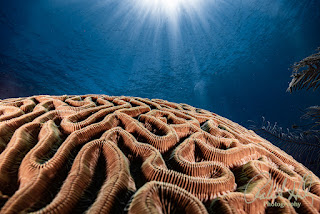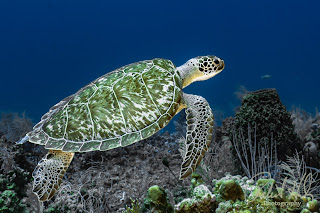AI Lens Blur in Lightroom: Simulating Depth for Underwater Photos
Creating a strong sense of depth in underwater photography is notoriously tricky and presents unique challenges for photographers. Whether diving in the clear, vibrant waters of Roatan, rich with marine life, or exploring a mysterious shipwreck in the South Pacific, you may find that everything looks flat and two-dimensional. This loss of depth perception is a common issue, as the magical blur that typically separates a subject from its background—something we often achieve topside with fast lenses—simply doesn't happen as readily below the surface.
In underwater photography, achieving the breathtaking depth of field that brings the subject to life can require careful planning and specific equipment. The hues of the ocean can further complicate this, often washing out colors and detail, leading to a lack of contrast. However, advancements in technology have introduced innovative solutions to overcome these hurdles.
But now, thanks to Adobe Lightroom's AI-powered Lens Blur tool, underwater photographers can simulate a shallow depth of field in post-processing with stunning realism. This tool empowers users to create visually compelling images without the need for expensive wide-aperture lenses or dual-camera tricks that were previously thought to be essential. Instead, you can utilize an innovative AI depth simulation feature that intelligently guides the viewer's attention exactly where it belongs in the frame. With Lightroom (Cloud) or Lightroom Classic 14.1 and newer, you can enhance your underwater images, adding that coveted depth and focus that will make your subjects pop against the mesmerizing, blue backdrop of the ocean.
Let's dive in.
🤿 Why Simulated Depth Matters in Underwater Photography
Underwater images often lack visual separation between foreground and background due to:
-
Small apertures (f/8–f/16) for sharpness and strobe exposure,
-
Haze, scatter, and limited natural light reduce contrast,
-
Over-detailed environments like reefs, where everything is in focus.
AI Lens Blur is a fantastic tool that lets us create beautifully soft backgrounds in a way that feels natural and is non-destructive to your images. It beautifully simulates the lovely depth of field you might get when using fast lenses on land. However, achieving that effect can be quite challenging when you're underwater. With AI Lens Blur, you can bring that vibrant depth to your underwater photos, making them stand out in a fun and creative way!
🧠 What Is AI Lens Blur?
AI Lens Blur is a fantastic tool that brings your images to life by creating a delightful simulated shallow depth-of-field effect! It generates a depth map of your image, which cleverly identifies what's in the foreground, mid-ground, and background. This means you can apply blur selectively to areas that aren't in focus, making your main subjects stand out.
Whether you're capturing the vibrant world of fish, the exciting action of divers, or the intricate details of macro critters, this tool adds a wonderful touch. It helps your subjects truly 'pop" off the page, giving them a beautiful sense of natural depth that traditionally required the perfect lens and distance combinations. So why not give it a try? You'll be amazed at how it can elevate your photography!
🧰 How to Use AI Lens Blur in Lightroom (Cloud-Based Version)
💡 Available in Lightroom Desktop (not Classic) as of version 2025.3
Steps:
-
Open the photo in Lightroom Desktop (Cloud).
-
Go to the Edit Panel > Effects > Lens Blur.
-
Click "Apply Blur" to generate the AI depth map.
-
Click on your subject to set the focal point.
-
Adjust:
-
Focal Range
-
Bokeh Amount
-
Bokeh Range
-
Highlights Glow for dreamy sunrays or shimmer.
-
-
Use Depth Map Preview to see how Lightroom interpreted your image.
⌨️ Shortcut:
Ctrl + 6orCmd + 6takes you directly to the Effects Panel.
Example: Sea Turtle in Open Blue Water
Challenge: The turtle is sharp, but so is everything else in the frame.
Solution:
-
Click on the turtle's eye to set focus.
-
Set Bokeh Amount to ~35%.
-
Reduce the Focal Range to isolate the foreground.
-
Enable Highlight Glow for natural sunlit softening.
Result: The turtle stays sharp and isolated, while the background gently recedes.
🧭 How to Use AI Lens Blur in Lightroom Classic (14.1 and Newer)
💡 As of version 14.1 (2024), Lightroom Classic also includes the Lens Blur tool natively, no need to switch platforms!
Steps:
-
Open your image in the Develop Module.
-
Scroll to the Effects Panel and find Lens Blur.
-
Click Apply to generate the depth map.
-
Click on your subject to set the focal point.
-
Adjust:
-
Bokeh Size (overall strength)
-
Focal Range (what remains sharp)
-
Bokeh Range (blur transition smoothness)
-
Highlights Glow (for added cinematic feel)
-
-
Preview the Depth Map for accuracy; manually refine with the brush tool if needed.
⌨️ Shortcut:
Ctrl + 6orCmd + 6opens the Effects Panel.
Example: Diver over Coral Shelf
Goal: Blur the reef background while keeping the diver tack sharp.
Steps:
-
Set the focal point on the diver's mask.
-
Adjust Bokeh Size to ~40%.
-
Tighten the Focal Range to isolate the diver.
-
Add the "Select Subject" AI Mask to sharpen the diver independently.
🧪 More Use Cases for Both Versions
🐙 Macro Coral Polyps
-
Use Manual Brush Refinement to exclude key polyps.
-
Blur surrounding wall textures to mimic focus falloff.
🐠 Clownfish in Anemone
-
Use Radial Gradient Mask or Invert Background Selection to blur the environment without touching the fish.
🌊 Diver in Silhouette
-
Combine Lens Blur with the Select Background mask to selectively soften the water around the diver.
🔄 Lightroom Classic vs Cloud-Based: Feature Summary
| Feature | Lightroom (Cloud) | Lightroom Classic 14.1+ |
|---|---|---|
| AI Depth Map | ✅ | ✅ |
| Lens Blur Tool | ✅ | ✅ |
| Depth Map Brush Refinement | ❌ | ✅ |
| Full Development Workflow | Moderate | Full control |
| Sync Across Devices | ✅ | Manual |
| Better for Mobile Edits | ✅ | ❌ |
| Better for Desktop Workflow | ❌ | ✅ |
🛠️ Best Practices for Oceanic Explorers
-
Avoid over-blurring — underwater shots benefit from subtlety.
-
Always sharpen your subject afterward to draw the eye.
-
Use Highlight Glow for light rays, reflective fish, or dreamy compositions.
-
Combine Lens Blur with other tools like:
-
AI Select Subject
-
Radial Gradients (
Shift + M) -
Brush (
K) -
Color Grading
-
📸 Before/After: Try It Yourself
Try applying AI Lens Blur to:
-
A reefscape with too much background detail.
-
A pelagic shot in open blue water.
-
A macro scene with busy textures.
You'll notice instant separation, better visual focus, and a more professional, layered look.
✅ Final Thoughts
Exciting news for underwater photographers! With Adobe's new AI Lens Blur tools, now available in both Lightroom Classic and Lightroom (Cloud), you have a fantastic opportunity to take your photography to new depths—literally! This innovative feature provides a fantastic, non-destructive way to create stunning depth in your images. You can easily guide the viewer's eye to the focal points of your photos, all while enhancing your edits, without needing to depend on wide apertures or perfect environmental conditions.
Imagine capturing a vibrant nudibranch gracefully swimming at 60 feet or snapping a shot of divers exploring the beautiful complexities of a reef wall. With AI Lens Blur, you can add a cinematic quality to your images, allowing you to express your unique vision more fully. Whether you're a seasoned pro or just starting out, this tool helps bring your underwater adventures to life like never before! Dive in and start experimenting with this fantastic new feature!
🐬 What's Next?
Give this a try on one of your top 10 underwater images. Watch how even a modest blur can turn a flat image into a professional one. Then, tag me on Instagram @robertherbphotography or share your before-and-after comparisons on my blog.
Until then, keep diving, exploring, and editing with purpose.
- 💡 Read more Lightroom tips at RobertHerb.blogspot.com.
- 💡 Get weekly updates when new blogs are published at: https://info.robertherb.com/lm-2-blog
- 💡 Join my upcoming online training program – Learn to enhance your underwater shots with Adobe Lightroom! Sign up for a FREE "Before & After" Gallery.
- 💡 Share your processed photos on social media using #RobertHerbPhotography.
- 💡 Questions or want help with your Lightroom workflow? Email me at bob@robertherb.com
Written by Robert Herb – Empowering underwater photographers to capture and enhance the beauty of our oceans.
Stay tuned for more in-depth insights into underwater photography. Let’s dive deeper into the art and craft of capturing the marine world! If you have any comments or suggestions, I’d love to hear them.
Get ready for an exciting underwater photography adventure! For more details on my upcoming online training course, check out my "Training" page at RobertHerb.com or email me at bob@robertherb.com.
Sincerely,
Bob Herb
|
|





Comments
Post a Comment
Please let me know your comments.